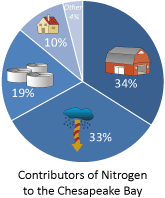Nutrients and Dissolved Oxygen: Overview
The high level of the nutrients nitrogen and phosphorus added to and recycled within the Bay is a primary cause of declining Bay.

Nutrient Sources
Excess nutrients come from wastewater treatment plants, animal farms, crop farms, development, and air pollution. The majority of nitrogen comes from fertilizer and manure from agricultural land use, followed the atmosphere, wastewater treatment plants, commerical and residential development, and other sources.

Phytoplankton's Role
These nutrients provide food to phytoplankton, tiny plants that live on the surface of the water. The phytoplankton grow rapidly, blocking sunlight needed for growth of grasses on the floor of the Bay.
As the phytoplankton die and decompose, a complex network of physical and biological interactions results in low dissolved oxygen in the bottom of the Bay, resulting in an environment where oysters, crabs, and other bottom-dwelling species cannot live.

Learn More
The video below provides a brief explanation of dissolved oxygen and its role in Bay health.
Video courtesy of the Chesapeake Bay Program. For more videos, visit their YouTube site.
